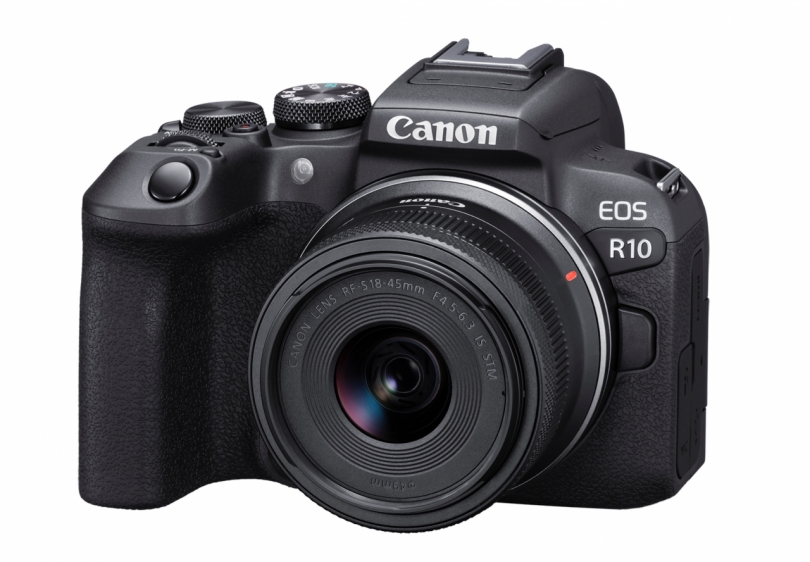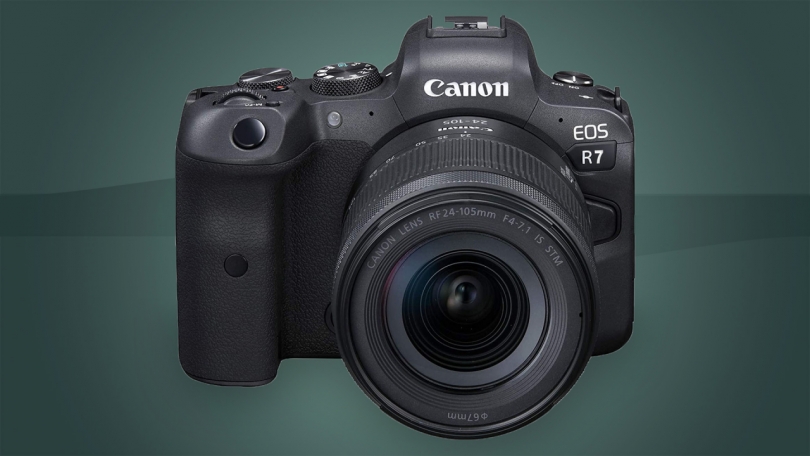
Introduction Canon has announced the first two APS-C cameras in its RF mirrorless mount. The EOS R10 is priced around the level of the core 'Rebel' cameras, while the EOS R7 has the price and features to put it a little above EOS 90D.
Looking at the existing EF-M mirrorless lineup, they approximate the EOS M5 and M6 II relationship.
Although Canon says this isn't the end for EF-S cameras (or EF-M ones, for that matter), it seems extremely likely that the move to incorporate APS-C into its RF mount leaves the existing systems living on borrowed time.
Both cameras are 4K/60 capable cameras that can shoot at 15 fps with mechanical shutter and share an impressively powerful and simple AF interface. Yet they're much more different than this might make them sound.
So, if these two cameras represent the future, what are they and how do they compare?
Sensors: resolution and shooting rate
The most obvious difference between the two cameras is that the less expensive EOS R10 has a 24MP sensor, while the EOS R7 has a 32. 5MP chip. We're told both sensors are distinct from the ones used in the Rebel T8i/ EOS 850D and the EOS 90D, and in both instances the new Rs appear to be significantly faster.
The new sensors and Digic X processors allow the R10 to shoot at up to 23fps in e-shutter mode, while the R7 can deliver 30fps. There's significant rolling shutter in both instances, which means it's the shared 15fps burst rate in mechanical shutter mode that's perhaps more relevant for a wider range of shooting scenarios.
Notably the R7 offers a much larger buffer than the R10, making it a more capable action camera. We found the R7 can shoot around 100 C-Raw images at 15 fps, whereas the R10 manages only 30 frames (2 seconds).
Interestingly, while both mechanical shutters can operate at 15fps, the R10's can only deliver a maximum shutter speed of 1/4000 sec, compared with the R7's 1/8000 sec. The R7 can also close its shutter when the camera is turned off, to reduce getting to the sensor as you change lenses.
In-body stabilization
The first fundamental spec difference you're likely to notice is that the EOS R7 includes in-body image stabilization. If combined with a RF-mount IS lens, the camera will co-ordinate its pitch and yaw correction efforts with those of the lens, to boost the overall level of stabilization. Translational movements and roll are handled by either the camera or lens, depending on which lens you use and whether you're shooting stills or video.
There's an almost impenetrable table detailing exactly what does what, when, but the key point is that you get five-axis stabilization in every combination.
Dial layout
The EOS R7 has an unusual command dial that encircles its AF joystick
The bodies of the two cameras are remarkably different, too. Both have twin control dials and both have a new, dedicate AF/MF switch on their front plates, next to the grips.
The front dials of both cameras are pretty similar and are set back behind the shutter button, but the rear dials are very different. The R10's dial is a conventional command dial, facing backwards on the top shoulder of the camera, whereas the R7 has a smaller, vertical dial that encircles its AF joystick.
Depending on how you look at it, this unusual dial is either exactly adjacent to where your thumb rests anyway or uncomfortably close to the joystick as you're trying to operate it.
Viewfinder and screens
The EOS R10 (pictured) has a smaller viewfinder and lower-res rear LCD than the R10, but at least retains a fully-articulated touchscreen.
Both cameras promise 2. 63M dot (1024 x 768 pixel) viewfinder panels, though behind rather different optics. The R10 has a relatively small finder with 0. 59x (equiv) magnification, whereas the R7 gets a bigger set of glass in front of its OLED panel, delivering a much larger 0. 72x (equiv) finder. Essentially that's the difference in size between the APS-C finder in the EOS 90D and the much larger, full-frame finder in an EOS 5D IV.
Canon has suggested that both panels run at 120hz when the camera is set to the more battery-intensive 'smoothness priority' mode.
The R7 has a nicer LCD panel, too. Both models have fully-articulated touchscreens but the R7 has a 1. 62M dot screen, to give a 900 x 600 pixel display, rather than the 720 x 480 pixel (1. 04M dot) panel of the R10.
Batteries and cards
The EOS R10's LP-E17 has around half the capacity of the LP-E6NH used in the R7, with predictable results for battery life.
A major difference between the two cameras are their batteries: the EOS R7 has a much larger 15. 3Wh LP-E6NH battery, which delivers close to double the battery life of the 7. 5Wh LP-E17 unit in the R10.
This table summarizes the CIPA battery life ratings of the two cameras, depending on whether you shoot using the viewfinder or rear screen, and whether you use power saving mode or choose to boost the refresh rate in smoothness priority mode.
Canon EOS R10
Canon EOS R7
Battery rating (LCD / EVF)
Smoothness priority
350 / 210
660 / 380
Battery rating (LCD / EVF)
Power saving mode
430 / 260
770 / 500
The EOS R10 squeezes its single UHS-II SD card slot next to its battery in a compartment under the camera, whereas the R7 has twin card slots that sit behind their own door on the side of the camera. This means it's much easier to access the cards on the R7, even if you don't particularly find yourself using both slots.
Video capabilities and overheating
There's a similar story of similarity and difference when it comes to the cameras' video modes. Both can shoot UHD 4K at up to 30p using all the pixels in the 16:9 area that spans their sensors. This means oversampled footage from 6K on the R10 and ~7K on the R7.
Canon warns that this oversampled footage may be temperature limited to around 30 minutes, depending on the camera's temperature and the ambient conditions. In both cases it specifically highlights the 29. 97p footage, so it's not clear whether this also applies to 23. 98p capture. A new on-screen indicator warns when the camera is getting increasingly hot, so you shouldn't be caught off-guard before encountering these limits.
Both cameras can also capture UHD 4K/60p footage from native (3840 x 2160 pixel) regions of their sensors. This means a 1. 56x crop for the 24MP R10 but a more significant 1. 81x crop from the 32. 5MP of the R7.
The R7 also lets you shoot 60, 30 or 24p sub-sampled footage (probably line-skipped) from the full width of its sensor. This means you can still shoot wide-angle at all framerates without having to worry about overheating, but also means you don't get the detail level or noise performance of the oversampled mode.
10-bit capture
Both cameras can shoot 10-bit HDR PQ video for natural-looking high dynamic range playback on HDR displays and TVs, but only the R7 also has the option to shoot 10-bit C-Log 3 footage if you want to conduct color grading.
The HDR PQ options extend beyond video, though, with both cameras able to shoot 10-bit HEIF files if you want to capture and display more dynamic range than you would get with a conventional JPEG and standard DR display.
Connections
The R7 (pictured) and the R10 both have USB-C sockets but the R10's remains a USB 2. 0 connector.
In terms of connectivity, the cameras differ somewhat. The R7 has a USB 3. 2 Gen 2 (10 GBit/s) port but, while the R10 also has a type-C socket, its port uses the older USB 2. 0 (480 MBit/s) style port. Both cameras can be powered or charged over these USB ports.
The EOS R7 also has a headphone socket, which the R10 lacks, so you'll need the more expensive camera if you want to check the audio levels and monitor for background distractions as you're recording.
Another difference is that, while both cameras can use wired and wireless remotes, the R7 also has an infrared sensor to allow its use with IR remotes such as the Canon RC-6.
Other differences
We found the smaller grip of the EOS R10 (pictured) worked better with smaller lenses.
As we can see, there are an awful lot of similarities between the two cameras but, collectively the differences start to add up.
We found the larger EOS R7 had a more comfortable grip, that was more comfortable to hold and gives more room around the knuckles if you mount a large RF lens on the front. The body is also weather sealed to some degree, which isn't true of the R10.
As has often been the case with environmentally-sealed Canon bodies, the R7 doesn't have a pop-up flash, whereas the R10 does.
Summary
Canon has a history of tailoring the specs of its cameras to appeal to certain audiences while being very sure that they don't tread on the toes of the more expensive models, and is frequently bashed using a fairly distasteful phrase for doing so. And the EOS R10 and R7 very much continue this tradition.
The R10 offers a solid spec that's competitive with its ~$1000 rivals, but the R7 offers enough more (IBIS, a bigger buffer, nicer viewfinder, weather sealing, faster shutter, bigger battery, headphone socket, Log capture and full-width 4K/60) to make sure that the less expensive model is no substitute. If they've planned the models well, you'll immediately know which one is right for your needs.
The bigger question is how they compare to Canon's EF-S and EF-M offerings. For now, you can put a smaller package together via the EF-M system and a mix of Canon and third-party lenses, or you can stick with the much, much wider lens range that's grown up for Canon's APS-C DSLRs. But, while we might see future models in both systems, it's hard to imagine they're going to match the AF performance or video capabilities of the R10 and R7.
Which, as is always the case with a young system, means it's a question of trusting Canon to deliver the lenses that you'd want to mount on these new RF-mount bodies.
. dpreview.com2022-5-26 17:00



